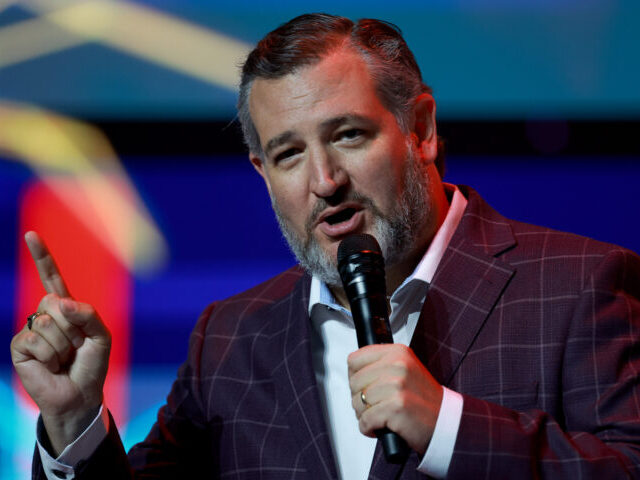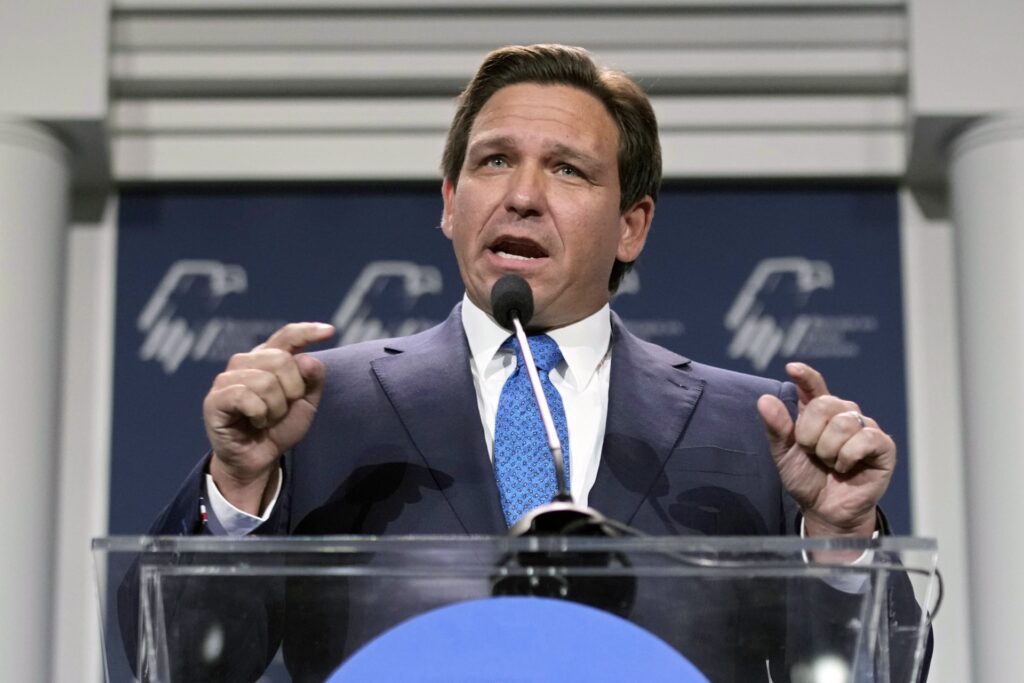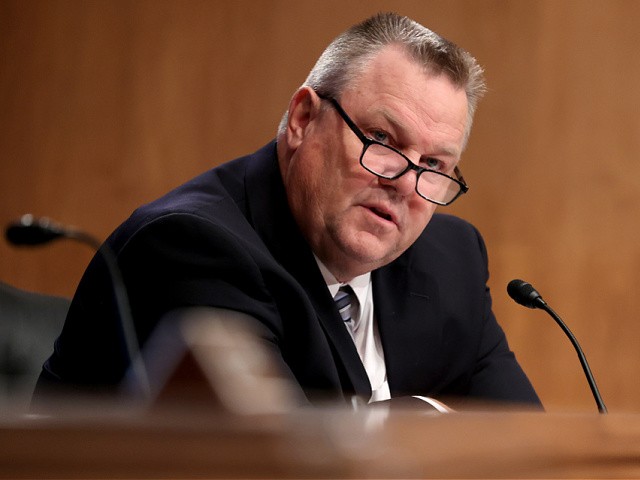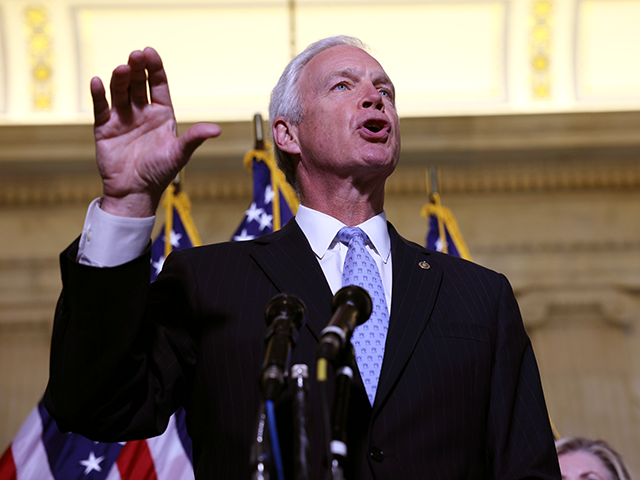Sen. Steve Daines (R-MT), the chairman of the National Republican Senatorial Committee (NRSC), told Breitbart News exclusively that the GOP sees a clear path back to the U.S. Senate majority in 2024 thanks to a favorable map that has Democrats on defense from the outset.
Republicans, to retake control of the chamber, only need to flip a net two seats from Democrat hands — technically only one if they win the White House as well — in the upcoming election. Given the map of which seats are up for voters in 2024, Daines said Republicans are very confident in their chances of retaking the chamber.
“As your listeners know, every two years one third of the U.S. Senate is up for reelection,” Daines said on Breitbart News Saturday on SiriusXM 125 the Patriot Channel this weekend. “In the 2024 cycle, there are 10 Republicans up but 23 Democrats. So, first of all, we start with an over two-to-one advantage in the number of seats we have to defend.”
The ten seats that Republicans currently control that are up for reelection in 2024 are Utah, Wyoming, North Dakota, Missouri, Indiana, Tennessee, Mississippi, Nebraska, Florida, and Texas. Technically, given the fact that now former Sen. Ben Sasse (R-NE) retired early, both Nebraska U.S. Senate seats will be up on the ballot — the full term for Sen. Deb Fischer (R-NE) and a special election for the seat that now Sen. Pete Ricketts (R-NE) holds.
“Of our ten seats we have to defend our two seats, that are the most difficult out of ten and these are not hard seats, are Florida and Texas,” Daines said. “So that shows you how good the map is for us.”
In a multi-tier Senate strategy for Republicans, in other words, tier one would be holding the GOP-held seats.
Florida has been a state trending more and more towards Republicans in recent years — in 2022, Gov. Ron DeSantis won by 19 points and Sen. Marco Rubio (R-FL) won by a similar margin. Texas, meanwhile, while long a pipe dream of the Democrats in recent years, has not seen a Democrat elected statewide in many, many years despite ongoing efforts by Democrats in state and nationally to try to do so.
“If you think about Florida, Rick Scott has confirmed he’s running for reelection,” Daines said. “You always want to make sure your incumbents are running again and Rick Scott — former governor of Florida, now Senator of Florida — he’s announced his reelect. Rick Scott is a great candidate. He will run a great campaign. Any Democrat who thinks they can beat Rick Scott I think is dreaming a bit but Rick is going to have a race and we have to make sure we’re going to support Rick Scott in that race. Then you go to Texas, with Ted Cruz, the Democrats — they hate Ted Cruz. The liberals hate Ted Cruz. They’ll raise a lot of money against Ted Cruz. Ted is going to have a race in Texas. That’s going to be, it’s always tougher than you think in Texas. But listen nobody is going to bet against Ted Cruz right now. We’ve got to support him and make sure he gets the resources he needs but Ted Cruz is going to win that race.”

Sen. Rick Scott (R-FL) speaks during a news conference after a closed-door lunch with Senate Republicans at the U.S. Capitol on May 17, 2022, in Washington, DC. (Drew Angerer/Getty Images)
So, if the Republicans hold everything they have currently—a very reasonable expectation given the map and what they have to defend—then they start from 49 seats as they enter Democrat territory and attempt to take some seats back. That’s where Daines says things get really interesting. Democrats are currently defending three incumbents, Sens. Jon Tester (D-MT), Sherrod Brown (D-OH), and Joe Manchin (D-WV), from states that former President Donald Trump won by huge margins in both 2016 and 2020.

Sen. Ted Cruz (R-TX) on stage during the Turning Point USA Student Action Summit held at the Tampa Convention Center on July 22, 2022, in Tampa, Florida. (Joe Raedle/Getty Images)
“These are formidable Democrats we have to go in and beat that have been elected in these red states for a reason — they’re very good politicians,” Daines said. “But this is a moment in a presidential election cycle year where the odds move into our favor. The focus at the moment is raising resources that we need so we can compete and recruit top-tier candidates. But you start with this map with the three red-state Democrats. These are Democrats in states like Montana, West Virginia, and Ohio. Keep in mind that these Democrats have not had to run in a presidential year since 2012, so it’s been 12 years since they’ve run in a presidential. I can tell you that in the presidential year of 2024, no matter who our nominee is, the Republican nominee for president will win Montana by 15 to 20 points, they’ll win West Virginia by 35 to 40 points, and they will win Ohio by 7 to 9 points.”
To keep the focus on these three seats, and to help the eventual GOP nominees in each of these states to ensure they have the funds needed to win in November, Daines and the NRSC have set up a special fund just for these three states.
“By the way, one thing that Democrats do very well is they leverage the small-dollar donor, you know, the 20 bucks or 30 bucks a pop online, and creating a massive tsunami as they did in this last election of money against Republicans,” Daines said. “I think some people believe that Republicans have all the money to campaign and Democrats don’t. The opposite is true. In some of those Senate races you mentioned earlier in races where we lost in 2022, we were outraised by three-to-one and four-to-one in every one of those races. It’s really tough to win when the Democrats own the airwaves. So we’ve set up a website, it’s Senate24.com. Any donation to that site goes to Montana, West Virginia, and Ohio, regardless of who our nominee is going to be. It’s a candidate fund that we will escrow the dollars now, build it up for the next year and a half, then we will transfer it to our candidate when we decide who the primary winner is and we’re in the general election.”
This fund is designed to steer dollars directly into the eventual GOP senatorial nominees’ campaigns in Ohio, Montana, and West Virginia, meaning they will have the ability to buy ads at cheaper rates than Super PACs and the eventual nominees will not have to start from scratch after possibly bruising primaries.
“We saw this in places like Ohio, like Pennsylvania, like Nevada — there were bruising primaries — and our Republican Senate candidates emerged from these primaries limping as it relates to funding because they had to spend the resources to win the primary,” Daines said. “We’re running against incumbents here, in West Virginia, in Montana, and in Ohio, so the Democrats will not have a primary. In some of these states, we will have primaries. So we can start raising money now, with small-dollar contributions — $25, $50 — to Senate24.com. We’ll just escrow that. Then we will transfer that to the winner of the primary the day after the primary is called and they will have a war chest to go into battle. Here is the other problem: When donors give to something like Senate24.com, in campaigns we call those hard dollars. In other words, those are campaign candidate dollars. There are also Super PACs out there that spend a lot of money, but the law requires that the candidate dollars get the much more attractive TV media rate than Super PACs. In Las Vegas in this last election, with the Nevada Senate race, the Las Vegas media market was charging 10 times more for a TV ad from a Super PAC than from a candidate. So it’s much more efficient for folks to give to Senate24.com because those are candidate dollars we transfer and they spend three to ten times more efficiently than a Super PAC does. Super PACs do a great job trying to save the country, but the candidate dollars are what we need most right now.”
In such a multi-tier Senate strategy for Republicans, then, tier two — the heavy focus tier that will draw most GOP energy and resources — will be these three states with Democrat incumbents facing reelection that Trump and Republicans have been winning big for years. So, for Tester, Brown, and Manchin to make it, Daines said, they will need “a massive amount of ticket-splitting for these three Democrats to survive this next election” and that recent trends in these states do not bode well for them.
“Keep in mind going back to 2012 for example in Montana in 2012 the last time Jon Tester ran there was only one statewide-elected Republican and 7 Democrats,” Daines said. “Today, there is only one statewid- elected Democrat left and that is Jon Tester. In West Virginia, it’s similar. Joe Manchin is the last statewide-elected Democrat in West Virginia. In Ohio, Sherrod Brown is the last statewide-elected Democrat. So it’s a daunting task for those three Democrats to win in 2024.”
So if the GOP holds tier one and flips at least two out of three seats in tier two, the Republicans get the majority back in the Senate. That does not even get into presidential battleground states where there are only Democrats up for reelection in 2024. This is where tier three comes in and it gets very interesting for Republicans as Democrats also have the following seats they currently control coming up in 2024: Michigan, Wisconsin, Nevada, Arizona, and Pennsylvania.
“Those will be Arizona and Nevada, which were absolutely razor thin in 2020 on the presidential. The Nevada Senate race that Adam Laxalt barely lost, that was 8,000 votes that he lost that race by, that’s 4 votes per precinct,” Daines said. “That’s razor thin. We’ve got a chance in Nevada to get it, especially in a presidential. Then, you go back to the midwest and further east and you’ve got Wisconsin, Pennsylvania, and Michigan. Those are all going to be presidential battleground states. Those were all very tight races in 2020 in the presidential. We’ve got a chance to put those races in play as well.”
So, theoretically, Republicans could — if they hold the red states and flip the three second tier seats back in addition to even just half of the presidential battleground states, get to 54 or 55 seats in the Senate. They could if they win them all get as high as 57 seats.
In recent years, Republicans have won each of these states — Michigan, Wisconsin, Nevada, Arizona, and Pennsylvania — in statewide contests. In 2016, Trump won all of these states except Nevada. In 2022, the GOP won the Nevada governor’s race and Sen. Ron Johnson (R-WI) won reelection in Wisconsin.
Daines argued too that Nevada’s U.S. Senate race was particularly close and could have easily swung the other way, in GOP candidate Adam Laxalt’s favor, had there not been a snowstorm in the northern part of the state on election day. Daines argued that Republicans need to get better at early voting and fighting out elections in the weeks leading up to election day rather than just relying on high election day turnout to win.
“Adam Laxalt’s race was breaking the right way for us but the Democrats, they do a much better job in their ballot harvesting and stuff,” Daines said. “But there was a snowstorm and so many of our voters wait until election day to vote. The problem is when that snowstorm hit our counties which is everything north of Las Vegas, Clark County is where Las Vegas is and that’s the big Democrat stronghold but the snowstorm hit all of our counties in the north all the way up to Reno and when you lose by 4 votes per precinct the weather was a factor out there. I’ve got to make an appeal to our patriots out there: We’ve got to get Republicans, conservatives, patriots voting earlier where it’s allowed in their states. We’re putting way too much on election day. We’ve got to be thinking about election month and making sure we get our ballots cast and our ballots banked because that’s what the Democrats do really well. We’ve got to do more of that where the law allows.”
Beyond the third tier of Senate races, a potential fourth tier may emerge of other possibly competitive Senate races where Republicans may have a shot at flipping Democrat-held seats in bluer states. Those, Daines said, include Virginia, Maine, Minnesota, and New Mexico. Republicans currently control all three statewide state-level elected offices — governor, lieutenant governor, and attorney general — in Virginia and they control one of Maine’s two U.S. Senate seats. Minnesota has not been won by a GOP presidential candidate since 1972, but Republicans have elected governors and senators in the not-too-distant past. New Mexico, meanwhile, has seen Republicans elected to the governor’s mansion back during the Obama administration when now-former Gov. Susana Martinez won, but it has been trending more blue in recent years. Asked about these longer-shot opportunities, Daines said the focus is on flipping the second and third tiers and locking in the first one but that Republicans would keep eyes on these other seats too.
“I spent 28 years in the private sector running businesses. I was at Procter and Gamble for 13 years. I started up a software company after that and took the company public. We were acquired. I’ve been driving businesses most of my life,” Daines said. “This is, politics is a bit of a new calling in my life. But what you learn in business is you drive focus to drive results. So we’re going to stay really focused, as you mentioned, on our pickup opportunities in those three states — that’s the Senate24.com movement we have. Then, we have the five presidential battlegrounds. Beyond that, and you listed a few — Virginia, Maine, possibly New Mexico or Minnesota — Virginia, I mean it’s been wonderful to see Gov. Youngkin. A Republican governor, a Republican Lieutenant Governor, a Republican Attorney General — Virginia can be a surprise state at times. We’re just going to keep watching these races to see how they evolve, what it looks like in terms of candidates that we have because if we have a great shot to win we’re going to be in there playing and fighting hard. But we also want to make sure we’re putting our resources on the map smartly. But we will look for ways to expand the map to put the Democrats further on their heels. The Democrats start off on their heels with this map. So the more we can kind of tip them over by expanding the map, we’ll look for those opportunities.”
Republicans nationally, Daines added, are prepared to help candidates in certain primaries to ensure electable nominees emerge — and to prevent internecine GOP civil war. He pointed to the first and most explicit example so far this cycle where the NRSC has formally gotten behind Rep. Jim Banks (R-IN) in the Indiana U.S. Senate primary as former Gov. Mitch Daniels and Rep. Victoria Spartz (R-IN) have declined to run, effectively clearing the way for Banks and stopping any major primary action there.
“I think what we found out painfully in 2022 is that sometimes candidates who can win a primary cannot win a general,” Daines said. “I am sick and tired of losing. We all are. The consequences of losing are severe. You look at 2024: If we don’t take the majority back, it’s probably the last bite at the apple we’ve got where we’ve got Democrats in red states. That doesn’t happen again until 2030. So, literally, we risk having the rest of the decade in Democrat control and having Chuck Schumer controlling the Senate. Imagine if a Republican wins the presidency, which I think we’ve got a great chance to do that, but we don’t have a Republican Senate majority — then we can’t move through his or her nominees. That is absolutely a disaster and that’s why you’ve got to win the presidency and the Senate to allow the president to move forward with his or her agenda. But regarding some of these primaries, yes we have gotten behind Jim Banks. Jim Banks will make a great Senator. We want to make sure we’ve got candidates who can win. Indiana is a little easier. It’s a red state. But we wanted to avoid having a collision where Republican candidates are spending a lot of Republican and conservative money to fight out a primary and it looks like we saved a bunch of money for everybody by clearing this for Jim Banks. We’re looking at every state. We’ll assess that. But my bottom-line principle is this: I want to see candidates who can win general elections.”
LISTEN TO SEN. STEVE DAINES (R-MT) ON BREITBART NEWS SATURDAY:




COMMENTS
Please let us know if you're having issues with commenting.